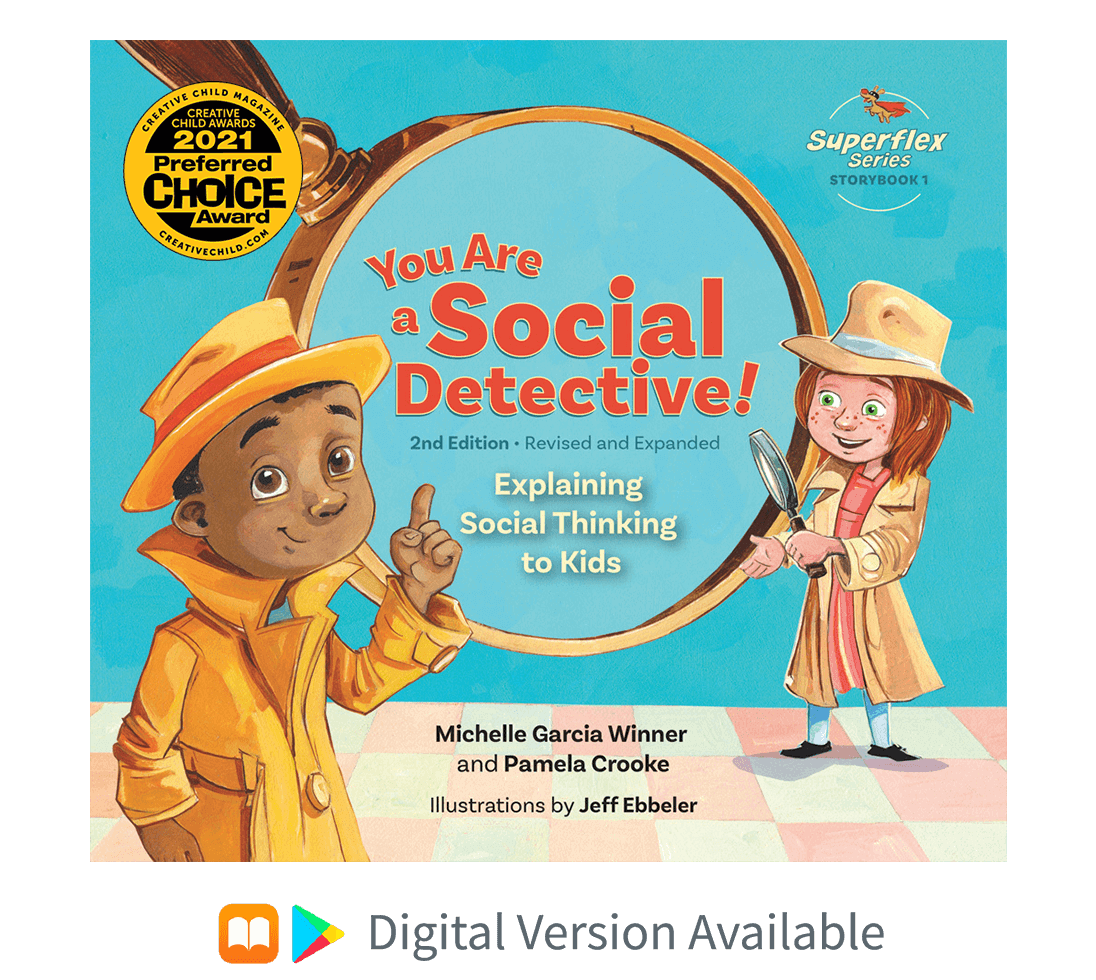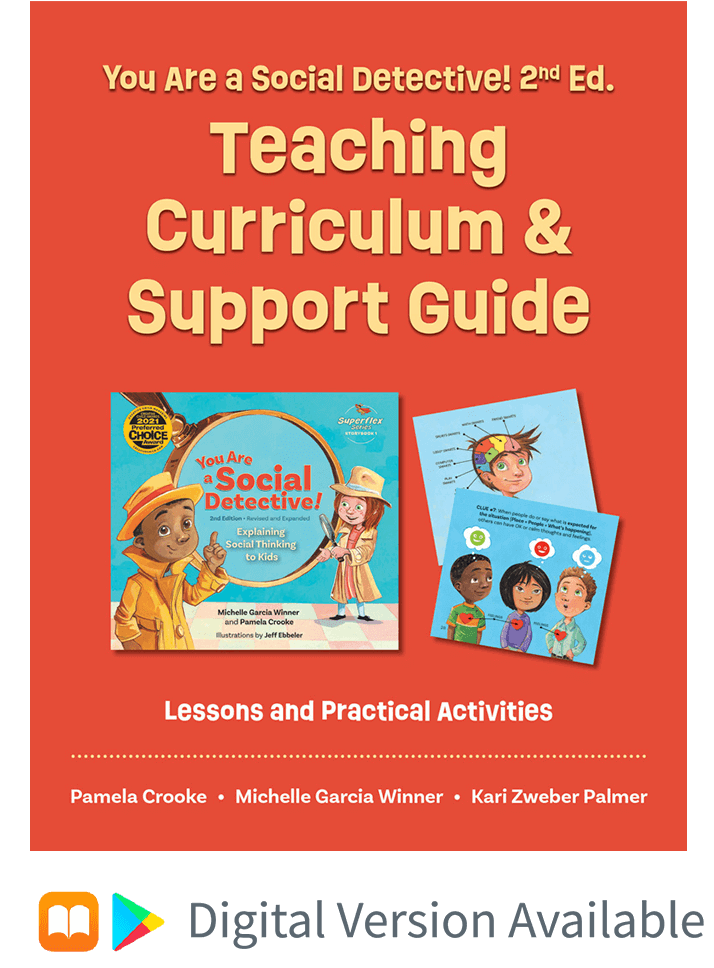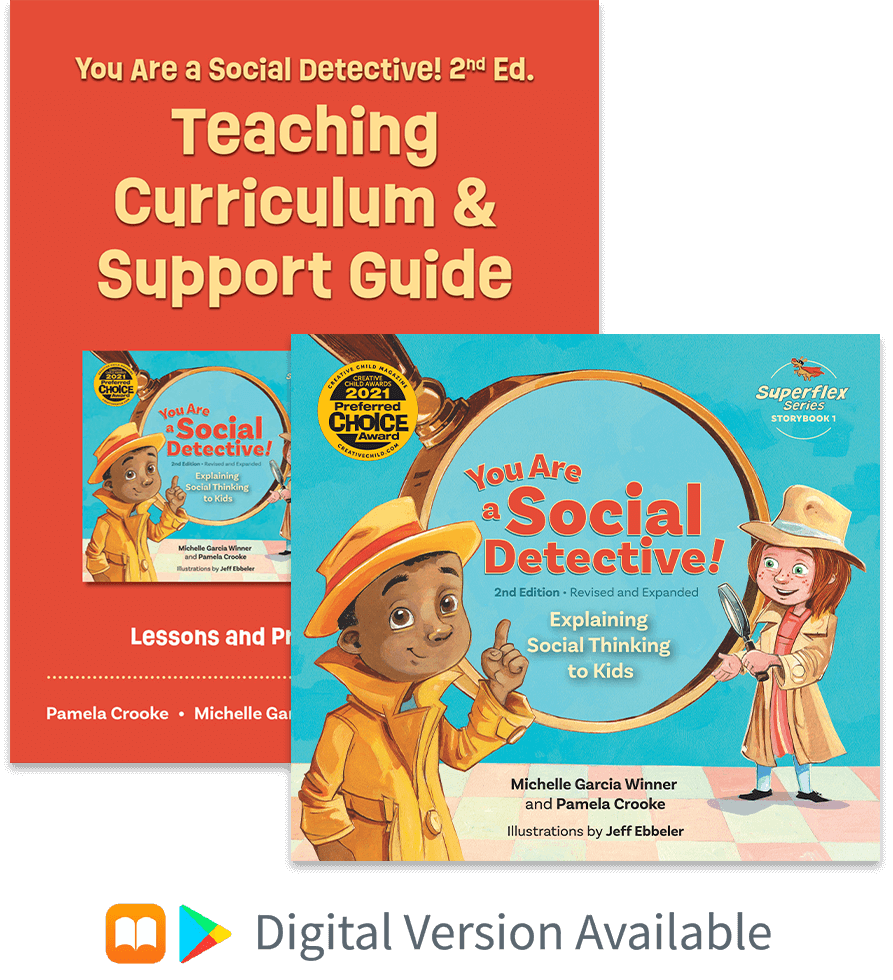
Part 2 of this two-part series explores
- The dos and don’ts of using Social Thinking® teaching materials
- Strategies to develop an inner coach and identify the self-defeater inner voice
- How to use the Superflex Curriculum in a mainstream classroom
- Strategies for teaching social emotional self-regulation
- Insight on what to do when kids outgrow the Social Detective and Superflex characters
Part 1 of this two-part series explains the critical scope and sequencing required to teach these materials and help your students, clients, and patients improve their social competencies for a lifetime. Learn how to modify this curriculum for use with older social learners.
3.5 hours of training and CE credit available for select professionals. For any special accommodations or assistance with resources email us.
Browse additional Social Detective & Superflex resources related this online training course.
Part 2: Using Social Competencies to Navigate in the Social World
Series Name: Social Detective, Superflex®, and Friends Take On Social Emotional Learning: Teaching the Concepts with Fidelity
In this second part of a two-part series, you will learn how to teach with fidelity the award-winning You are a Social Detective! and Superflex…A Superhero Social Thinking Curriculum to boost social awareness and self-regulation. We continue to explore many different social thinking strategies for navigating in the social world. Learn how to teach Superflex in the mainstream classroom, in-person, or online. Discover the dos and don’ts when using Social Thinking® teaching materials.
Replay access through November 30, 2023
Detailed Description
Who should attend
This two-part series is filled with creative activities to help your students, clients, and patients move from being “Me” thinkers to “We” thinkers. Join us to explore core treatment* concepts you can use with social learners from K–12 and learn how lessons connect to academic standards. Our strategies can be used in the mainstream classroom to help everyone improve reading comprehension, written expression, conflict resolution, and work as part of a group. We also discuss the connections between the Social Thinking® Methodology and social, emotional, and academic learning (SEAL) programs, positive behavioral interventions and supports (PBIS), and response to intervention (RTI).
In Part 2: Using Social Competencies to Navigate in the Social World we continue our journey by exploring many different social thinking strategies, then put that knowledge and skill together to practice and learn more about navigating in the social world:
- The dos and don’ts of using Social Thinking® teaching materials
- Developing an inner coach and identifying the self-defeater inner voice
- Activities and strategy ideas from interventionists that can be used and adapted for face to face or distance learning
- How to use the Superflex Curriculum in a mainstream classroom
- Strategies for teaching social emotional self-regulation
- Using a power plan to support self-awareness, self-monitoring and self-control
- Explore UnthinkaBots (formally Unthinkable) and Thinkable duos
- What’s after Superflex? What to do when kids outgrow the Social Detective and Superflex characters
Course Content Disclosure: This course focuses on the use of Social Thinking’s books You are a Social Detective! and Superflex…A Superhero Social Thinking Curriculum to teach social competencies. Our intention is NOT to market the products, but instead to demonstrate how to teach with fidelity and highlight scope, sequence, and pacing of the curricula in the manner for which they were designed.
If you began your learning about this this topic with this course, please watch Part 1: Me in the Social World—It All Starts with Social Self-Awareness in the series to learn background information and other key lessons that require teaching prior to jumping to the lessons taught in Part 2.
Who Should Attend
The Social Thinking Methodology is used by a wide variety of professionals; including speech-language pathologists, special and general education teachers, social workers, counselors, clinical and school psychologists, occupational therapists, behavior specialists, and school administrators to name a few. It’s also used by family members and caregivers across settings.
About this Series
Social Detective, Superflex®, and Friends Take On Social Emotional Learning: Teaching the Concepts with Fidelity
This two-part series is packed with strategies and activities to help your students, clients, and patients learn more about the social world and how to navigate to self-regulate within it. Social Detective thinking, Superflexible thinking, UnthinkaBots (formally Unthinkables), and Thinkables are our backdrop for this teaching.
Part 1: Me in the Social World—It All Starts with Social Self-Awareness
Part 2: Using Social Competencies to Navigate in the Social World
Throughout this series, we’ll break down the journey using practical and engaging strategies and activities. We always start by learning more about how the social world works before exploring how to work within it.
Series Content Disclosure: This course focuses on the use of Social Thinking’s books You are a Social Detective! and Superflex…A Superhero Social Thinking Curriculum to teach social competencies.
Our intention is NOT to market the products, but instead to demonstrate how to teach with fidelity and highlight scope, sequence, and pacing of the curricula in the manner for which they were designed.
Learning Objectives and Agenda
Objectives
Participants will be able to:
- Describe how the Superflex Curriculum can be used to motivate social learning engagement, social problem solving, self-awareness, self-monitoring, and/or self-control.
- List two strategies to support self-monitoring and/or self-regulation.
- Explain how teaching social observation, interpretation, social problem solving, and self-regulation are aligned with academic standards (e.g., speaking and listening, reading literature, and writing).
Agenda
- 1 hour and 20 minutes
- Explore strategies for some common UnthinkaBots (formally Unthinkables) and the Thinkable powers we can use to help support our flexible thinking
- Explore the social-academic connection
- 2 hours and 10 minutes
- Connect skills and learning through a Power Plan to identify and manage UnthinkaBots
- Learn how to extend Superflex lessons for all students through PBIS.
- Discover how to extend the same concepts through a new lens for middle and high school students
- Previously Recorded Q & A
Continuing Education Credit
3.5 hours toward CE credit, if applicable
Click here to see if you can receive CE credit by Profession and by State
We are proud to provide access to continuing education credit for:
- Speech-Language Pathologists
- Educators
- ...and others!
Technical requirements to participate in online training
Streaming compatible browser
The best browser for streaming is Google Chrome. If you are unable to use Chrome, please make sure the version of your browser is the latest and greatest.
Download ChromeHigh-speed internet connection
Make sure you are accessing the online course on a device that is connected to high speed internet—that means your download speed is at least 25Mbps.
Run Internet Speed TestOpen firewall ports
If you are accessing the online course from your school or organization, ask your network administrator if there are any firewall ports that need to be opened.
Learn More











